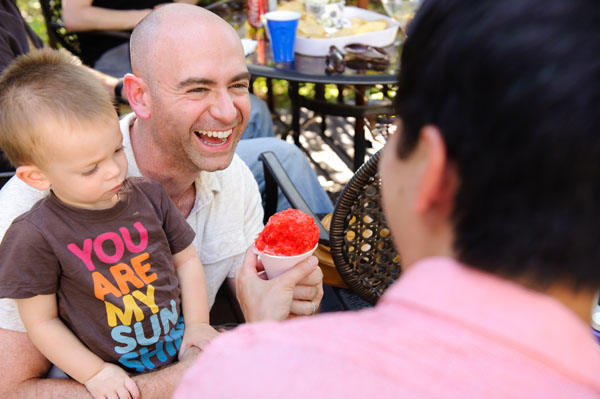Share
Meet the New Guy – 10 Questions with PhotoShelter’s New CEO
At the beginning of May, Allen announced that he would be stepping aside as CEO of PhotoShelter to take on the role of Chairman of the Board. “...

At the beginning of May, Allen announced that he would be stepping aside as CEO of PhotoShelter to take on the role of Chairman of the Board. “This move will enable me to focus on our strategic vision, travel to more speaking engagements, and talk with more of you,” said Allen. “I’m also very happy to say that we’ve named Andrew Fingerman, our VP of Marketing for the last 4.5 years, as the new CEO of PhotoShelter.”
 Many of you already know Andrew from seeing him at various events, talking with him on the phone about your business, social media, or even stopping by the office to say hello. But now we want to give the entire community the opportunity to learn more about Andrew — his background, his commitment to PhotoShelter, and his vision for the future.
Many of you already know Andrew from seeing him at various events, talking with him on the phone about your business, social media, or even stopping by the office to say hello. But now we want to give the entire community the opportunity to learn more about Andrew — his background, his commitment to PhotoShelter, and his vision for the future.
So here you have it: 10 questions with PhotoShelter’s new CEO, Andrew Fingerman.
1. Can you give us some brief background on what you did prior to PhotoShelter?
The road to PhotoShelter for me has been long and filled with lots of great experiences, so I’ll try to hit the key facts.
I went to the University of Michigan for undergrad. I studied political science there, and became convinced I’d pursue a career in politics or journalism. So after Michigan, I headed back home to the east coast and found a role in a small political campaign consulting firm. Looking back, I was fortunate to get started here, working on a diversity of campaigns. This job taught me valuable marketing skills, most notably the critical need to have empathy for the audience. I’ve taken this with me ever since. Above everything else, it helps to see things through the customers’ eyes.
From there I did a brief stint in corporate communications for tech companies at a large PR agency, and then I got the startup itch. I helped start a company called Venture Architects, doing business plan consulting for emerging companies. This was another great learning experience, getting exposure to hundreds of innovative companies. Wanting to formalize my understanding of business strategy and finance, I took some time to pursue my MBA from Columbia University.
After Columbia I was recruited to work for American Express, specifically in OPEN, the small business division. This was an incredible experience for me. I have so much respect for the way American Express has built and sustained a service brand, and how the people who support that brand truly live the values of the company and drive that into their jobs. During my time at Amex, I managed product marketing projects for a full spectrum of charge cards for small business.
And then five years ago the call came from PhotoShelter, looking for a leader for the marketing team. I jumped at the chance to do something more entrepreneurial and work in a creative community.
2. You’ve always been a photography enthusiast. When did you start getting seriously interested in photography and how has that developed since you’ve been at PhotoShelter?
As a kid, I used to take a ton of pictures, especially at sporting events. My grandpa had two incredible NY Giants season tickets in the third row and I would bring my (crappy) camera to every game, take dozens of photos from a position still too far away, and pester my parents to develop roll after roll. Starting in high school, I started to get more into photography and really enjoyed darkroom work as a creative outlet. I saved up and bought an SLR, the Nikon N2000, which I still have. I had two great teachers in high school – one of which happened to take photos part-time for the Giants. When I joined PhotoShelter in 2008, I found him through the SportsShooter community.
PhotoShelter has obviously given me a platform to expand my love of photography, and work on my own technique too, inspired by photographers who are one million times more talented than I am. These days, I’m nothing more than the nutty dad who doesn’t put the camera down at events with family and friends.
3. What went into the decision for Allen to take on the position of Chairman of the Board, and to transition you from VP Marketing to CEO?
PhotoShelter is about to turn 7 years old. Looking around, we’ve seen some companies “grow up” and lose touch with their original goals and ideals, and then their product loses its soul. So, for several months we’ve been thinking about exactly that – how to keep growing PhotoShelter while focusing deeply on solving problems for working photographers and maintaining our brand as an approachable, fast-moving thought leader. This thinking touches on product evolution, marketing, our role in the photography community, and on our leadership within the PhotoShelter team. We arrived at the very honest notion that at different stages, companies will require different kinds of leadership. Allen has been a driving force behind the evolution of PhotoShelter for years, and he will continue to do so. As the demands of running the day-to-day business grow, we feel that it is important for us to create space for Allen to think about vision and product strategy, and keep talking to photographers. This move frees him up to do just that.
As for my promotion, the selection was about continuity. I’ve been working within the photography community for almost five years; I understand our culture and our role in the industry, and I’ve built some incredible relationships with photographers.
4. What about PhotoShelter makes you want to work here and take on the role of CEO?
That’s easy. 1) Our mission to use technology to help photographers succeed. 2) Our people, who give me the pleasure of working on a team where not one person simply treats their role like “just a job”. That’s a real gift. 3) The photography community, through which I’ve developed some incredible friendships and on a daily basis give me the opportunity to see images of this world and current events in ways beyond the imagination. That combo may sound ridiculously cliche, but I really thrive in environments where everyone is excited about the bigger picture, and the double bonus is that we work in a creative business.
The people who work here at PhotoShelter care so much about how we can help photographers run and grow their businesses. It’s easy to lead a group of people who take that much passion and drive it into everything they do. Showing up for work every day, this massive print by Guillaume Gaudet is the first thing that I see, and I’m reminded of how lucky I am to be here.
Now would be a very appropriate time to mention that we’re hiring.
5. What can members expect from PhotoShelter in the next three months? In the next year?
In the immediate term, we’re razor-focused on product optimization. We recently overhauled the internal photo management area in an effort to streamline the workflow for photographers and modernize the interface. We introduced new capabilities like nested collections, QuickSend of high res downloads, and more powerful permission capabilities for client galleries and downloads. Quite candidly, we feel like there’s work to be done to ensure that the tools meet the initial promise of a simple, streamlined workflow. So our product team has been digesting member feedback, executing several new rounds of user testing, and we’ve planned a series of short release cycles that focus on usability and small feature enhancements. (The first of which is happening this week – see the latest system update post in the forums.)
We are then turning our attention to the next generation of PhotoShelter websites and photography display tools. Because many members have asked, I’ll note that for this next major leap forward we are planning to build in an optional beta period that will emphasize user testing.
6. What do you think differentiates PhotoShelter from similar services in the photo industry?
We’ve always distinguished PhotoShelter with our commitment to pro photographers. It’s easy enough to get a simple website these days, but you can’t get one that’s built for professional photography and backed by the set of powerful tools that we’ve assembled over time. I don’t see another service out there that offers website customization (templates or manual design) plus the full spectrum of tools that can support a photography business online, including the ability to upload and store a wide spectrum of pro file types, an internal and external archive search, the wide variety of image sales/licensing options, marketing tools to attract new clients, inbound and outbound FTP capabilities, and so many other ways to deliver images to clients. The breadth of pro tools are really what makes us different, and we’ll continue to look for ways to introduce more of these for our members.
Beyond the product itself, I think that we occupy a unique space in the industry thanks to our efforts to help educate photographers and push their careers forward. Our team is a contributor to the photo community itself with our educational resources and in-person events, and we’re approachable – this makes a difference to working photographers. When you call PhotoShelter you get a Client Services representative on the phone who’s excited and prepared to help you out until you’re all set.
7. As CEO, how do you plan to continue establishing and growing PhotoShelter’s relationship with the photography community?
We can always stand to deepen our relationship with photographers. My plan is to do this through a mix of large and small opportunities.
On the larger scale, we have our Luminance event in September, which I’m really excited about because it creates a TED-like gathering where a bunch of very smart people can come together and discuss their ideas about the future of photography, and those of us in the audience (including me) will have a chance to learn a lot from them. Attached to the Luminance event is a workshop where photographers can work on technique alongside Joe McNally, Zack Arias, Corey Rich, and Robert Seale.
We’ve also gotten a lot more aggressive on the education front. Our schedule calls for us to release at least one new educational guide per month in order to continue growing our library of free business guides for photographers, and we’ll be hosting at least one new guest webinar every month, including more from our “What Buyers Want” series (check out the webinar schedule for more). The positive feedback we’ve received on our educational efforts has been very rewarding.
The photo industry associations have always been a great conduit for us to further our relationships with photographers. For the second half of the year, we’re sponsoring the APA Photo Assistant Basic Training and the ASMP Photographers Helping Photographers series – both regional U.S. events taking place at different times throughout the year.
In a less structured sense, we will stay very open to working with smaller organizations that have similar goals. Last night, for example, I (along with several members of the PhotoShelter team) attended the Friends of Anton photojournalism auction at Christie’s, where the work of some of the world’s greatest photojournalists was auctioned to support the family of Anton Hammerl, who was killed in Libya last year. PhotoShelter made a donation last week to help support this event. It gives me great pride to be involved in the community in ways like this.
Finally, I think there is huge opportunity for us to get better acquainted with the pro photo community outside the U.S. We’ll be looking at ways to better understand the needs of photographers abroad so we can be thoughtful about fashioning the service to solve problems for them as well. This will likely involve a healthy mix of travel, surveys, and Skype.
8. What major photo industry trends do you see that contribute to your thoughts and planning?
Mobile is one of the most significant industry trends I see that has the potential to influence our planning going forward in terms of photography websites. Video, of course, is another. But beyond specific technologies, I see the biggest trend impacting photographers to be the influx of “less pro” alternatives in every specialty – like Instagrammed photos appearing on magazine covers and ads, snapshots by citizen journalists used as part of news articles in major media outlets, etc. What does this mean for us? We need to continue producing solutions that help photographers cement their client relationships and continue to be relevant, important players for whoever their clients might be – because happy clients will remain the best safeguard against competing alternatives.
9. You’ve said that “listening” to photographers is going to be the cornerstone of your leadership at PhotoShelter. Can you tell us more about what you mean by this and how it’s going to influence what members see in the product?
Listening, for me, is the primary way we will unlock new opportunities to improve PhotoShelter and make our tools even more useful. We have a huge, diverse community. Not one single specialty is more than 10% of our photographer base. So, it is critically important to me that our entire team really understands how individual PhotoShelter photographers are using the system, and how they work outside of PhotoShelter as well. We pay a ton of attention to the suggestions and feature requests that come in, but I want to push well beyond these. So we’re organizing a series of deeper conversations that dig into individual photographers’ workflow and business challenges. We’ve already started booking these, in the form of lunches and Skype calls. For those interested in participating and don’t mind getting poked by engineers, product managers, client services reps, and marketers – let us know in the comments below.
10. And just for fun – when you’re not at PhotoShelter, what are you doing?
I squeeze every bit of scarce free time into being with my family. I run a startup civic association in my community. During football season, I get a little crazy over fantasy football. And, I cook, preferably on the grill.





